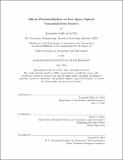| dc.contributor.advisor | Cahoy, Kerri L. | |
| dc.contributor.author | Gallo, Leonardo de la | |
| dc.date.accessioned | 2024-06-27T19:52:24Z | |
| dc.date.available | 2024-06-27T19:52:24Z | |
| dc.date.issued | 2024-05 | |
| dc.date.submitted | 2024-05-28T19:36:59.914Z | |
| dc.identifier.uri | https://hdl.handle.net/1721.1/155423 | |
| dc.description.abstract | Free-space optical communications (FSOC) is a growing field that presents an attractive alternative to the the current technology standard of radio frequency (RF) communications. Typical optical carriers have smaller SWaP in comparison to RF systems due to the difference in required aperture sizes. The narrower beam divergence of optical wavelengths also results in a higher power efficiency for long range communication links. This improvement in performance can be leveraged by platforms constrained by size, such as satellites. For the past ten years, the number of satellites launched has increased by an order of magnitude, with smallsats currently making up 96% of the launched vehicles. The use of FSOC terminals for smallsats enables higher data rates but requires precise pointing. An example nanosatellite FSOC mission, NASA’s CubeSat Laser Infrared CrosslinK (CLICK) B/C addresses this by using a beacon-based pointing, acquisition, and tracking (PAT) system to correct for angular misalignment while an avalanche photodiode (APD) receiver detects the communication signal. The high gain of the APD allows the communication signal to be detected at link distances ranging from 25km to 580km for CLICK-B/C. In this work, we consider whether higher sensitivities may be achieved by using a Silicon photomultiplier (SiPM) as a receive optical sensor. SiPMs are arrays of APDs operated in Geiger mode, characterized by nanosecond output pulses and gains in the order of 106 electrons per photon. This thesis proposes using a SiPM in a 2x2 pixel configuration as a dual pointing and communication sensor for FSOC terminals in LEO. In this configuration the misalignment of the optical signal between the transmit and receive terminals can be directly measured by the SiPM, eliminating the need for a dedicated beacon laser and quadcell detector used for PAT. This reduces the overall SWaP of the communication terminal by a factor of 2. The pointing performance of the proposed SiPM configuration is characterized by calculating the noise equivalent angle (NEA) of the detector through simulation and experiment, and the communication performance is evaluated by testing the maximum detectable pulsing frequency of a laser. The simulation results support an NEA of 1µrad and a maximum detectable pulsing rate of 2GHz. | |
| dc.publisher | Massachusetts Institute of Technology | |
| dc.rights | In Copyright - Educational Use Permitted | |
| dc.rights | Copyright retained by author(s) | |
| dc.rights.uri | https://rightsstatements.org/page/InC-EDU/1.0/ | |
| dc.title | Silicon Photomultipliers as Free Space Optical Communication Sensors | |
| dc.type | Thesis | |
| dc.description.degree | S.M. | |
| dc.contributor.department | Massachusetts Institute of Technology. Department of Aeronautics and Astronautics | |
| mit.thesis.degree | Master | |
| thesis.degree.name | Master of Science in Aeronautics and Astronautics | |
